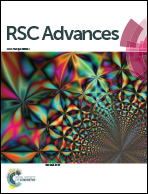Thiolate-protected golden fullerenes. A 32-ve core involving a hollow Au32 cage†
Abstract
We have computationally investigated the possible formation of large hollow gold nanostructures based on a Au32 core covered with a thiolate layer using relativistic density functional theory calculations. We have found that [Au32@Au12(SR)18]6− is a plausible candidate that retains the structural, electronic and spherical aromatic properties of the Au32 cage of its parent bare Au32 golden fullerene. The study shows that the low-energy part of the optical spectrum can serve as a guide to identify such hollow gold structures among other small-sized gold nanoclusters with similar nuclearities. The low-lying excited states are dominated by 1f → 1g transitions, which significantly distinguish hollow clusters from other nanoclusters, like the prominent [Au25(SR)18]− cluster, whose low-lying excitations are dominated by 1p → 1d transitions. The gold nanoclusters studied here can serve as model compounds for assessing the metallic core size effects on the absorption energies and the influence of the surface structure of the gold core on the cluster properties. The present study suggests that it is also plausible that even larger hollow structures derived from Au42, Au72, and Au92 golden fullerenes can exist.


 Please wait while we load your content...
Please wait while we load your content...